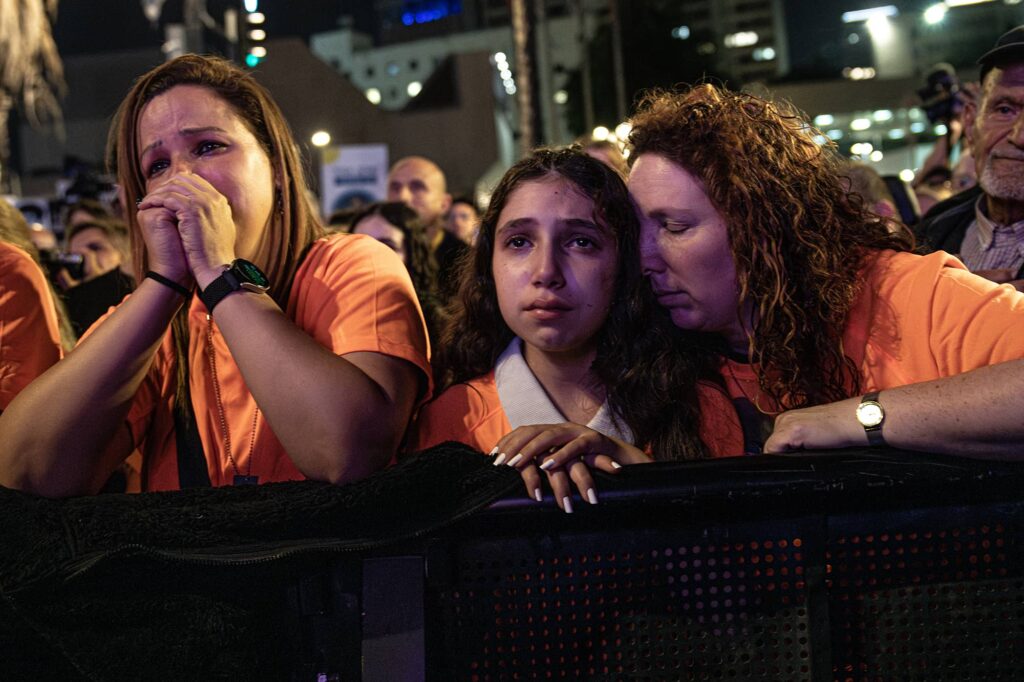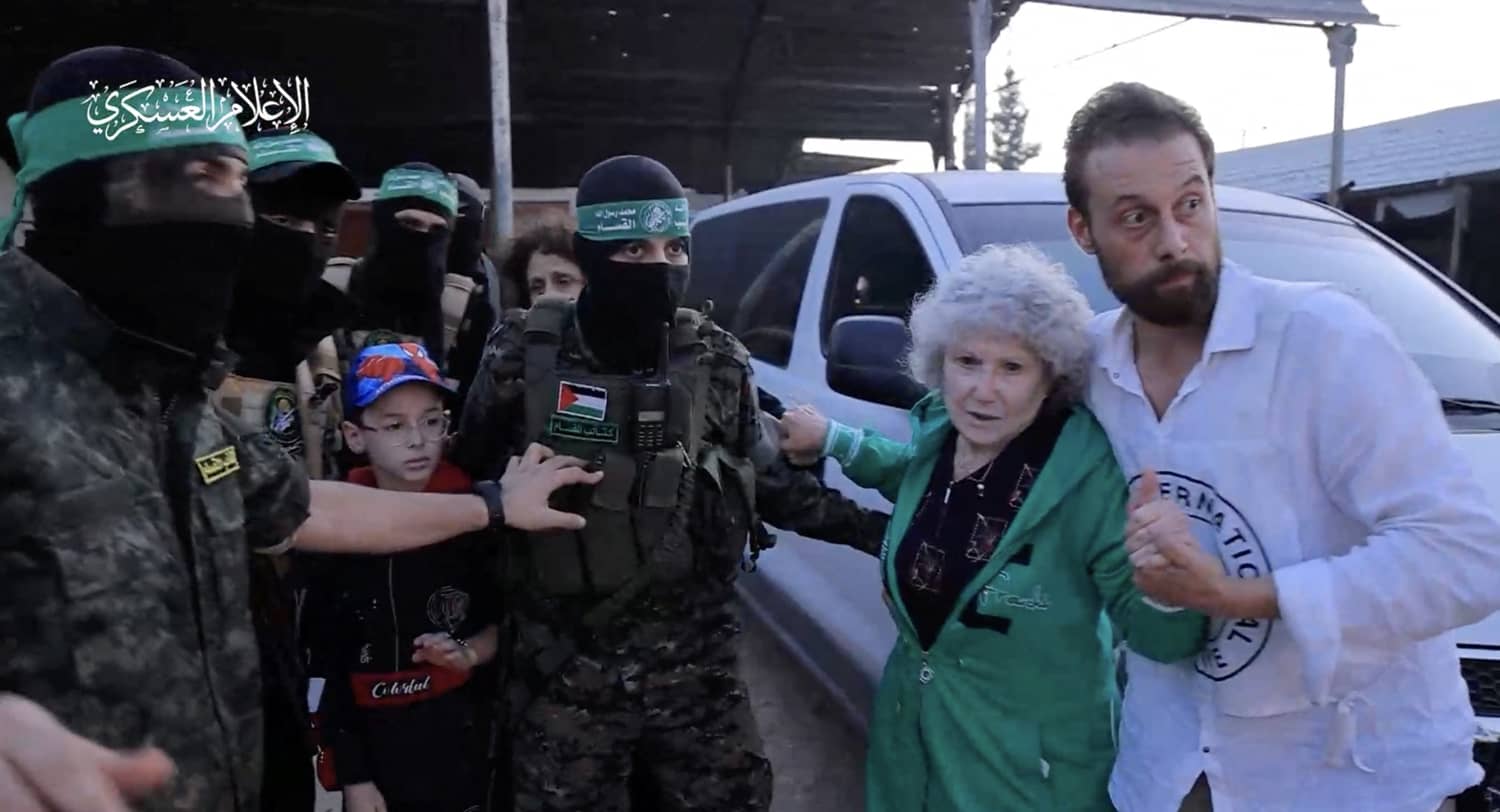There is nothing rational, let alone normative, about a situation where a terror group and its affiliates took 240 people hostage – toddlers and elderly people, children and women, young revelers abused and then abducted from a desert rave, as well as soldiers (both women and men) surprised in their bases. The numbers keep changing slightly, as some individuals are now confirmed to have been killed (and in some cases, their bodies are held in Gaza). Others, missing and presumed dead, now turn out to be in Hamas’s hands.
>> Insight from Israel: Read more from Eran Lerman
Hamas refused to grant the captives any access by the Red Cross, and in a manipulative way used and continues to use them as bargaining chips so as to position itself as a redeemer of Palestinian prisoners – and to shield itself from the consequences of its own actions by imposing a prolonged pause.
Regardless of all other aspects of the war, it is the sheer human drama of the hostage situation which commanded the intense engagement of Israelis (and many others around the globe). The names and faces, the compelling stories of horror and of courage and grace under pressure, and then the dehumanizing scenes of the releases in Gaza (“keep waving”, the Hamas captors ordered) – all took powerful hold over the national agenda and over people’s daily lives. So did the anguished calls of those who still have relatives held, and the mass demonstrations in TeI Aviv demanding their release now.
In Israel, no amount of sober policy advice, in the face of Hamas’s manipulative mind games, could quell the urge to “bring them back.” The public space in front of the Tel Aviv Museum – across the street from the IDF and Ministry of Defense Headquarters – has become “The Square of the Abducted.” Thousands joined a march to Jerusalem to call for their release. In every town in Israel a thoroughfare was lined with empty chairs of all sorts, each bearing a portrait. Worldwide, the posters were hung (and in some places, shamefully torn down).
For the government, as well as for the soldiers in the field, bringing back the hostages became one of the two stated goals of the war, alongside the defeat of Hamas. The bitter claim of the invaded communities and the families – that both the government and the military failed to prevent this from happening on October 7 – lent an urgent edge to their demands: and so did the fears, now enhanced by the stories of those who came back, for the health and safety of those still held.

By mid-November, as the slow relentless Israeli ground incursion put Hamas under increasing pressure, the negotiations became more focused, and by Friday, November 24, a week-long “humanitarian pause” in the fighting took hold. Night after night for one week hostages were released:
81 Israelis, mostly children and elderly women, in return for three times as many Palestinian prisoners – women and minors convicted of terror-related crimes (but not actual murderers).
Three dual-national Russian Israelis “as a gesture to Putin.”
24 hostages from other nations, mainly Thai workers on the kibbutzim, apparently through the Thai government’s intervention with Iran.
The releases were not solely the result of Israel’s military pressure, although Prime Minister Binyamin Netanyahu, in a rare press conference on the night of December 2, seemed to take much of the credit as he recited the names of the children who came back. A confluence of other interests (and some ground-breaking models of cooperation between intelligence agencies) also made the releases possible.
For President Joe Biden the releases were a matter of intense human interest, in particular, the case of four-year old Abigail Idan, an American citizen, whose parents were murdered in front of her eyes before she was carried off to Gaza. But they were also a framework for negotiating a pause (not a “ceasefire,” a term the Administration was careful to avoid) enabling growing amounts of humanitarian supplies to be delivered, and thus allaying some of the concerns raised domestically and internationally about the situation in Gaza. Biden thus dispatched CIA chief William Burns to Doha to speed the negotiations.
The interests of three other parties were also in play:
Qatar hosted the four-way meeting (Israel, the US, Egypt and Qatar) and at times put pressure on the Hamas leadership in Doha. They even took the unprecedented step of sending a delegation of their intelligence service officers openly to Israel for talks about the modalities of the next stage. Israel reciprocated, despite the Israeli public’s anger over the Qatari role as supporters of Hamas. Qatar’s positive role was acknowledged by Netanyahu himself and his National Security Adviser Tzahi Hanegbi.
For Egypt, Gaza has a direct bearing on the situation in Sinai and thus on Egypt’s national security. While the Egyptian diplomatic corps avoids Hamas, Intelligence Chief Abbas Kamel has direct leverage to bring to bear, not so much on the Hamas leadership in Qatar but on the actual masters of the situation down below in the tunnels of southern Gaza. It was important for Egypt not only to be at the table but also to be seen worldwide to facilitate the physical acts of hostage release on its soil in most cases.
Hamas itself wanted an opportunity to delay (and perhaps stop altogether) the IDF onslaught, arrange for resupply for their forces, improve their local defenses and blind the overhead intelligence monitoring their activities – no drone or aircraft flights were carried out over the southern part of the Gaza Strip during the pause, and in the northern part they were restricted through most of the day. The release of women and minors in the West Bank and East Jerusalem further raised their prestige there. A high percentage of West Bankers in a recent poll support what Hamas perpetrated on October 7. Last but not least, the release ceremonies, with rowdy crowds expressing hate towards Israel while disciplined black-clad Hamas troops maintained control, served as a demonstration that even in parts of Gaza City, let alone in Rafah, the Hamas chain of command holds and is still quite far from losing control of the situation.
These demonstrations of Hamas “power” also served as a reminder to the Israeli public that the other goal of the war, the destruction of Hamas rule in Gaza, needs to be implemented. There were no dissenting voices in Netanyahu’s (absurdly) large full cabinet – 41 ministers – as to the need to resume the fighting once the pause was over. The stories of deprivation and abuse which began to seep out – contradicting Hamas’ dictated texts and gestures of “praise” (including letting one captive teenager keep her pet dog) – added to the abiding, fierce anger over the horrors of October 7, which refuses to die down. By late in the night of November 30, with the intermediaries unable to secure from Hamas the release of ten women Israel has reason to believe are still held, the pause collapsed, and fighting indeed resumed on December 1.

Still, the impulse to destroy Hamas does run to some extent contrary to the equally powerful hope to see all hostages released. Netanyahu’s forceful words at his press conference cannot entirely paper over the tension. This may also have an effect on his already strained relationship with Defense Minister Yoav Gallant, who is suspected by Netanyahu loyalists of being less than enthusiastic about the manner if not the substance of the Prime Minister’s performance.
At of December 6, 137 hostages are still thought to be in the hands of their abductors (Hamas, Palestinian islamic Jihad, the Popular Front for the Liberation of Palestine, and local criminal elements): two children (a toddler and a baby – but Hamas claims that they and their mother have been killed); 20 women, mostly young; 106 men, old and young alike; and nine Thai workers. How many of them are alive is uncertain. As evidence from those released was added to existing intelligence, Israel determined that six of the 137 hostages are dead and their bodies held by Hamas.
The repeated mantra in Israel is that military pressure led to the release of the hostages and renewed military advances – this time towards Yahya Sinwar’s stronghold of Khan Yunis – will lead to further releases. This is not a baseless assertion, and the channels to negotiate further releases remain open, although the Mossad mission has been pulled out of Qatar.
Ultimately, Yahya Sinwar and his military commander Muhammad Deif are not going to entirely let go of their valuable “assets,” given what they have learned about the intensity of Israeli feelings, unless they can use the hostages to bring about a full halt to Israel’s campaign. Painful decisions thus lie ahead for Israel’s war cabinet.



